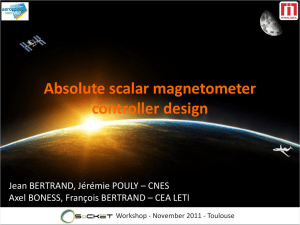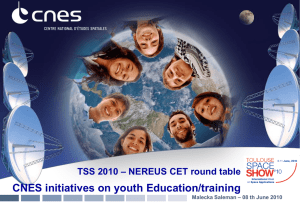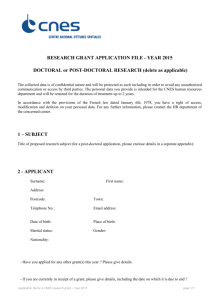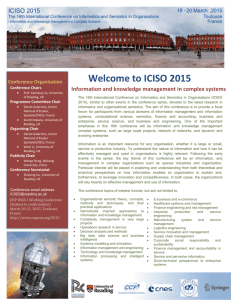Ocean Surface Topography Constellation
advertisement
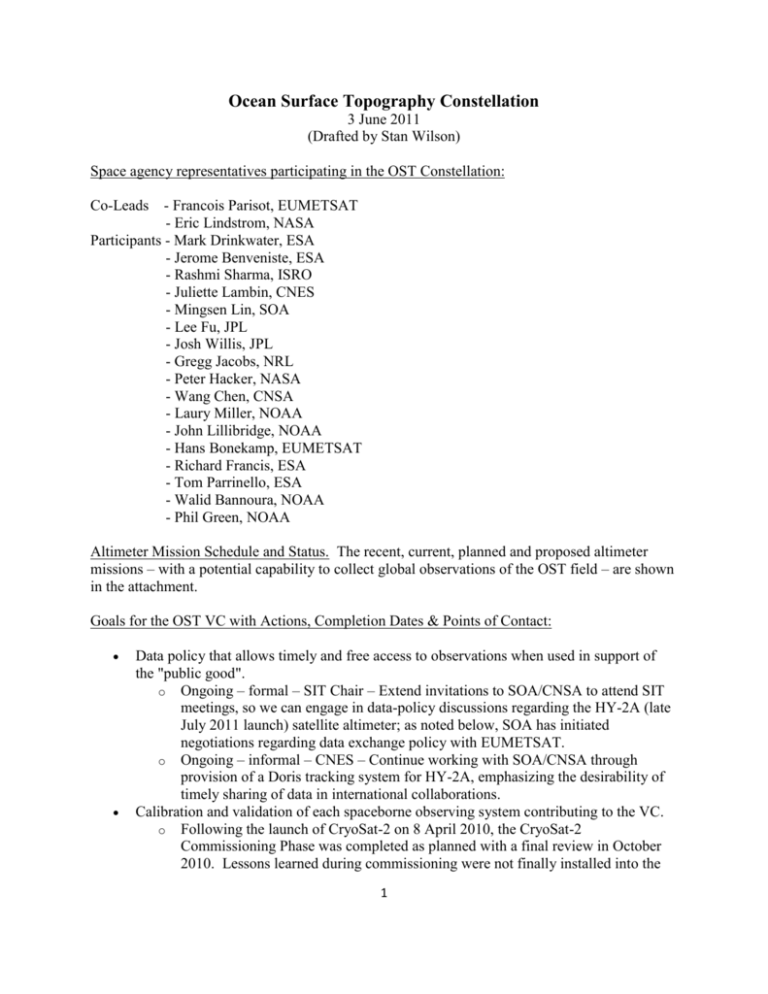
Ocean Surface Topography Constellation 3 June 2011 (Drafted by Stan Wilson) Space agency representatives participating in the OST Constellation: Co-Leads - Francois Parisot, EUMETSAT - Eric Lindstrom, NASA Participants - Mark Drinkwater, ESA - Jerome Benveniste, ESA - Rashmi Sharma, ISRO - Juliette Lambin, CNES - Mingsen Lin, SOA - Lee Fu, JPL - Josh Willis, JPL - Gregg Jacobs, NRL - Peter Hacker, NASA - Wang Chen, CNSA - Laury Miller, NOAA - John Lillibridge, NOAA - Hans Bonekamp, EUMETSAT - Richard Francis, ESA - Tom Parrinello, ESA - Walid Bannoura, NOAA - Phil Green, NOAA Altimeter Mission Schedule and Status. The recent, current, planned and proposed altimeter missions – with a potential capability to collect global observations of the OST field – are shown in the attachment. Goals for the OST VC with Actions, Completion Dates & Points of Contact: Data policy that allows timely and free access to observations when used in support of the "public good". o Ongoing – formal – SIT Chair – Extend invitations to SOA/CNSA to attend SIT meetings, so we can engage in data-policy discussions regarding the HY-2A (late July 2011 launch) satellite altimeter; as noted below, SOA has initiated negotiations regarding data exchange policy with EUMETSAT. o Ongoing – informal – CNES – Continue working with SOA/CNSA through provision of a Doris tracking system for HY-2A, emphasizing the desirability of timely sharing of data in international collaborations. Calibration and validation of each spaceborne observing system contributing to the VC. o Following the launch of CryoSat-2 on 8 April 2010, the CryoSat-2 Commissioning Phase was completed as planned with a final review in October 2010. Lessons learned during commissioning were not finally installed into the 1 operating chains until end-January 2011; consequently, the general data release to all PIs was delayed until then. The 1-3 February CryoSat Cal/Val Workshop confirmed the excellent performance of the new SAR interferometric altimeter. o The Cryosat Project intends to produce a complete set of CryoSat Meteo/Oceanography products to meet the needs of this community according to the following baseline: products will be made available within 3 hours (70% of time), 2-3 days, and 30 days after acquisition; the 3-hour products are to be online by end of year, and two months later, the 2-3-day & 30-day products; the project does not plan to extend the ground segment to include additional stations to reach the 100% for the 3-hours product. o The Cryosat Project is providing full access to the current products, and welcomes collaboration with NOAA in validating and improving these new products. The Project also intends to involve CLS in validating and improving ESA's ocean products, including the fast delivery mode. The generation of inter-calibrated data product(s). o Ongoing – With a continuing series of altimeters flying since 1992, a number of efforts have been developed to address the need to inter-calibrate and then integrate products from multiple altimeter missions; two of the most significant ongoing efforts are AVISO and RADS. The Archiving, Validation and Interpretation of Satellite Oceanographic (AVISO) data effort (http://www.aviso.oceanobs.com/) is a largely French-funded effort (CNES, CLS, SHOM, Meteo France, LEGOS and CERFACS) using its Duacs and Ssalto system to collect data from various altimeters, generate harmonized products and make them available in near real time and delayed mode for hourly to climate times scales. It has been particularly useful enabling the application of altimeter data to operational oceanography and forecasting mesoscale variability. The Radar Altimeter Database System (http://rads.tudelft.nl/rads/) is an effort of the Department of Earth Observation and Space Systems at the Delft University of Technology and the NOAA Laboratory for Satellite Altimetry to establish a harmonized, validated, and cross-calibrated sea level data base of satellite altimeter data. RADS represents a capability to compare and contrast data and associated errors from different satellites, in order to generate integrated multi-mission data sets, a capability particularly appropriate for providing the best possible estimates of global sea-level rise. Easy access to selected subsets of the resulting data products. o While AVISO and RADS also offer easy access to integrated products, they do not provide those products within three hours of collection by the satellite, a time constraint imposed by operational marine forecast centers for access to the altimeter-derived significant wave height (SWH) product. Aug 2011 – Mark Bourassa, Florida State U – Develop and demonstrate a single-point-of-access ("portal") to facilitate easy access to selectable subsets of the integrated, multi-altimeter global significant wave height (SWH) field in an easy-to-use format and within three hours for 2 operational (and research) use; he is also incorporating multi-scatterometer ocean vector winds as a complement to SWH. Aug 2011 – Paul Chang (w/Stan Wilson), NOAA & Volker Gaertner, EUMETSAT – There are two prospective venues for holding second training course on the Use of Satellite Wind and Wave Products in Marine Forecasting – (1) the Center for Weather Forecasts and Climate Studies (CPTEC) of the National Institute for Space Research (INPE), Cachoeira Paulista, São Paulo, Brazil or (2) the IOC/IODE Facility in Oostende, Belgium. Both prospects require the demonstration of the single-point-ofaccess as noted above. INPE/CPTEC – the preferred option This option is dependent on securing the funding required to underwrite the travel of students to attend the course; the availability of such funding should be known in the coming weeks. This option has the advantage of the GEMPAK/N-AWIPS operational forecast software already available on its computers, as well as access to operational meteorological data streams. IOC/IODE Facility – the fall-back option This option is dependent on the identification of a display software package that can be: Installed in an ordinary PC. Taught to students in a day or two. Installed on IOC computers to display OVW & SWH with NWP output (analyses & forecasts) for comparison. Taken home for use in an operational setting. Funding for student travel is not an issue for this option. Proceeding with this second course is dependent on either funding being secured for option (1); or if that is not possible, option (2) is dependent on the identification of a suitable display package and collection of meteorological data for Southern Hemisphere case studies; assuming one of these is pursued, the next steps are to: Schedule the course, Identify students in developing countries of the Southern Hemisphere, Identify marine-weather case studies from students’ regions of interest, Collect OVW & SWH, as well as NWEP output, corresponding to those case studies, and Conduct the course – the earliest possible date, assuming the two initial prerequisites are accomplished, is December 2011. Harmonization of launches and orbits to optimize coverage in space and time. 3 o o o o o o ENVISAT. Since 22 October 2010, ENVISAT has been in a new orbit that is not exact-repeat; therefore the Sea Level Anomalies can no longer be computed from the mean repeat profile, and a gridded mean sea surface is now used, introducing an additional error (internal coherency tests point to a 1–3 cm global error with peaks >10cm in high mesoscale regions [Dorandeu, 2011, CryoSat Workshop]). Nevertheless the data are still being used for mesoscale monitoring by organizations such as AVISO. Meanwhile, the large-scale oceanographic applications are ensured by Jason-1 and Jason-2 currently providing the needed repeat-track data. CryoSat, which is not optimized for operational oceanography, will soon contribute to high-density mesoscale monitoring, with a degraded performance due to the lack of a microwave radiometer for the wet tropospheric correction, but perfectly suitable for such applications. Jason-1. Jason-1will be kept in its current orbit, maintaining the interleaved mission with Jason-2 until data from the upcoming SARAL/AltiKa can be launched and its data validated; once those data are validated and assuming that the Jason-1 mission remains viable, it will be moved to a geodetic orbit in the range of 1286 ± 2 km, or a suitable geodetic orbit in line with the spacecraft’s capabilities at the time. (See section on page 4 about Jason-1 end of life plans.) SARAL/AltiKa. The launch was announced by the ISRO Chairman to be December 2011; the CNES payload module has been completed and tested, and its qualification review is planned end of February 2011; according to CNES and ISRO, data from SARAL will be free and unrestricted with operational users getting near-real-time data from EUMETSAT and offline data from CNES and ISRO. HY-2A. The HY-2A satellite is currently in assembly, integration and testing; the DORIS flight model was delivered at the end of 2010 and is currently being integrated; launch is planned for late July 2011. Discussions regarding data exchange policy have been initiated with EUMETSAT. Access to HY-2A data might be possible after the cal/val phase; however no announcement is expected before that time; one of the criteria to authorize data access may very well be data quality. Sentinel-3A & -3B development proceeding nominally; instrument level Critical Design Reviews (CDR) began in 2010 and are proceeding nominally and scheduled to be completed in spring 2011; ground segment CDR is currently planned for end 2011; launcher procurement ongoing; launch of S-3A scheduled in 2013; the first Sentinel-3 Mission Advisory Group meeting was convened in January 2011 by Mission Scientist Craig Donlon to provide advice to ESA and EUMETSAT on various issues in relation to the ongoing development activities, and calibration and validation. Jason-3. All agreements have been signed and development of flight and ground elements has started; a system synthesis design review was held in early February 2011; the selection of the launcher is planned for mid-April, 2011; and the target launch date is second half of 2013. This schedule assumes that the availability of funding as proposed; this will be an issue since NOAA funding in FY11 has remained at the FY10 level of $10M, vice the $50M planned; proposed FY12 4 funding is $53M and there is the possibility of that being held at the FY10 level as well; this will significantly delay the planned launch date of 2013. o Jason-CS. EUMETSAT and ESA have resumed preparatory work on Jason-CS, the satellite series to follow Jason-3; various meetings between EUMETSAT, ESA, NOAA, and CNES have been/are being held to establish a concept for cooperation, which is near agreement; ESA member states have allocated funding within the GMES Space Component for preparatory activities; initial feasibility studies with industry have already been performed; a 14-month Phase B1 design study with European industry started in November 2010 which will proceed directly into Phase B2 during 2012; the decision for the implementation phase, Phase C/D/E1, is expected at the end of 2012; the Jason-CS series will have 2 satellites (a third may be added), each with a nominal 5-year lifetime; the first is planned for launch in 2017 with at least a one-year overlap with Jason-3, and launch of the second Jason-CS spacecraft is planned for 2022. Development and demonstration of systems capable of collecting improved observations. o Lindstrom, NASA and Lambin, CNES – Proceed in the definition of and planning for a Surface Water Ocean Topography (SWOT) mission, a wide-swath altimeter (this section awaits an update from NASA/CNES). SWOT was the focus of the special science meeting, Towards higher resolution remote sensing of ocean dynamics and terrestrial surface waters, held on October 21-22, in Lisbon, Portugal. A NASA & CNES SWOT Team has reached agreement on joint workshare and responsibilities and proposes its formal acceptance by the agencies; a Phase A Study to be initiated in early/mid-2011, with launch planned in 2019. o Lindstrom, NASA and Lambin, CNES – Proceed in the definition of and planning for a Surface Water Ocean Topography (SWOT) mission, a wide-swath altimeter. NASA and CNES exchanged letters of interest in the SWOT mission with a 2019 targeted launch data following the meeting of CNES President d’Escatha and NASA Administrator Bolden in September in Washington. SWOT was the focus of the special science meeting, Towards higher resolution remote sensing of ocean dynamics and terrestrial surface waters, held on October 21-22, in Lisbon, Portugal. NASA & CNES have reached agreement on a joint work-share and responsibilities framework for SWOT. NASA is supporting CNES in industrial studies of spacecraft and instrument system in 2011 with an anticipated NASA transition to Phase A by early 2012. A Technical Interchange Meeting involving the NASA and CNES teams is scheduled for late February at JPL. Discussions on a formal agreement on joint implementation of SWOT is expected in the near future. In December 2010, the CSA sent a letter of intent expressing interest in participating in the SWOT mission and contributing Canadian Extended Interaction Klystrons (EIKs), an essential component of the SWOT radar transmitter and other activities. NASA responded last month with a letter 5 of approval of the CSA interest and accepted CSA’s proposal to begin development of a formal agreement. Proposed orderly termination of missions reaching end of life. o Jason-1 is still operating within specifications despite serious signs of aging – many of its redundancies have been lost, and the GPS is dead; following an "end of life" working group and considering recommendations from the OSTST and the Joint Steering Group (while a CNES and NASA mission, NOAA and EUMETSAT have been invited to participate) adopted, it was decided to: Assuming that Jason-1 stays healthy, its tank was to be depleted as much as possible, leaving enough hydrazine to keep Jason-1 in its current orbit; once validated SARAL/AltiKa data are available, Jason-1 would then be moved it to a lower orbit to continue its science mission without risk to others. The objective is to keep Jason-1 in its current orbit until the end of the cal/val phase of SARAL/AltiKa – likely to be the 1st half of 2012. If the scientific mission is no longer viable and it can still be maneuvered, Jason-1 to be transferred to a cemetery orbit a few kilometers below its present orbit with the remaining fuel; if it cannot be maneuvered; it will be made passive in its current orbit. If still viable after the cal/val phase of SARAL/AltiKa, Jason-1 would be moved to a geodetic orbit in the range of 1286 ± 2 km, or a suitable geodetic orbit in line with the spacecraft’s capabilities at the time. The Jason-1 tank was to have been had been depleted as much as possible this past July to minimize risk of an explosive collision in the future; however, tank depletion operations were interrupted because of a thruster anomaly and only 70% of the desired depletion was achieved; investigations are on-going to review possible scenarios regarding possible thruster usage, risk assessment with respect to fuel tank remaining pressure, and science impact of the different options. Note that NASA and CNES funding has not yet been approved for Jason-1 beyond 2011. o The ERS-2 mission is still operating after 17 years, although there is no more onboard recording. During the remaining half year of operation, ERS-2 will be directed at meeting needs of the ice and InSAR community, while the low-bit-rate instrumentation (including the Radar Altimeter) will be utilized on a best effort basis. This last phase of the mission will repeat the ERS-1 Ice Phases of 1992 and 1994, with the objectives directed at ice stream dynamics, ice-sheet mass balance, and landslides; this will feature a threeday-repeat orbit operating at a 6-km-lower altitude. Given the growing risk of space debris-induced incidents, ESA has completed plans for de-orbiting this satellite, its first Earth Observation to be de-orbited from low Earth orbit; de-orbiting will be performed in three phases between early June and mid-July 2011 by decreasing the satellite’s 6 altitude below 600 km while maintaining the circular orbit, and later lowering the perigee until un-priming the remaining fuel and de-activating the satellite; the time between the start of the ERS-2 de-orbiting activity and its re-entry in the atmosphere is planned to be within 25 years; while this will not be a controlled re-entry, studies are ongoing on how ERS-2 will burn up during atmospheric re-entry. Forthcoming Meetings of Note: A second International CryoSat Workshop was held at ESA-ESRIN from 1-3 February, 2010 (http://www.cryosat2011.org/). The workshop provided a forum for information exchange, including: the CryoSat Mission status and performance; Level 1 and 2 data processing and products; tools available to PIs; calibration and validation results; product quality and outlook for improvement; exploitation of CryoSat data; and international context including synergies with programs from other space agencies. SARAL Science Workshop was held at ISRO, Ahmedabad, India 15-17 March 2011. The meeting focused on technical and scientific aspects of SARAL mission, data, cal/val and science issues. 7
